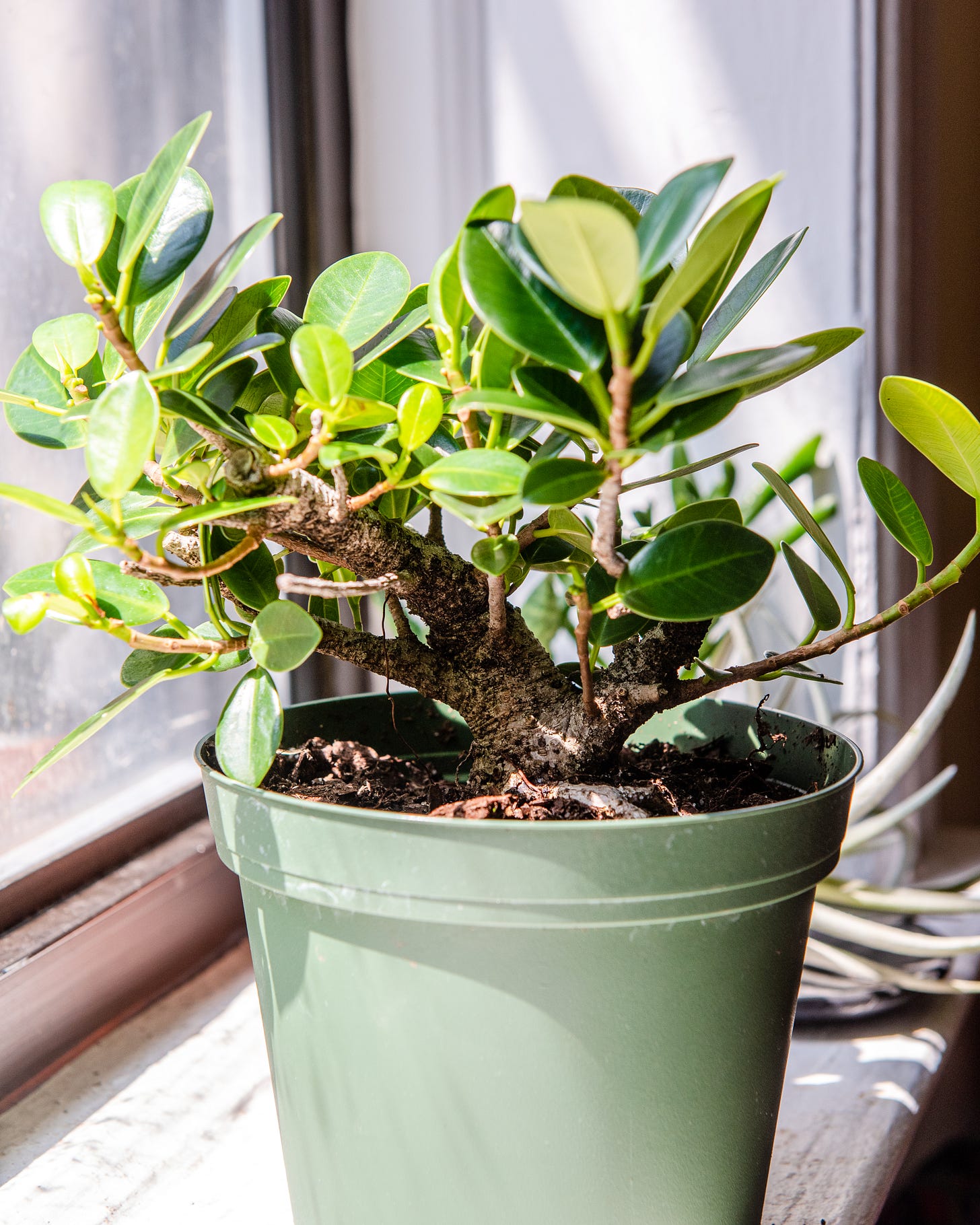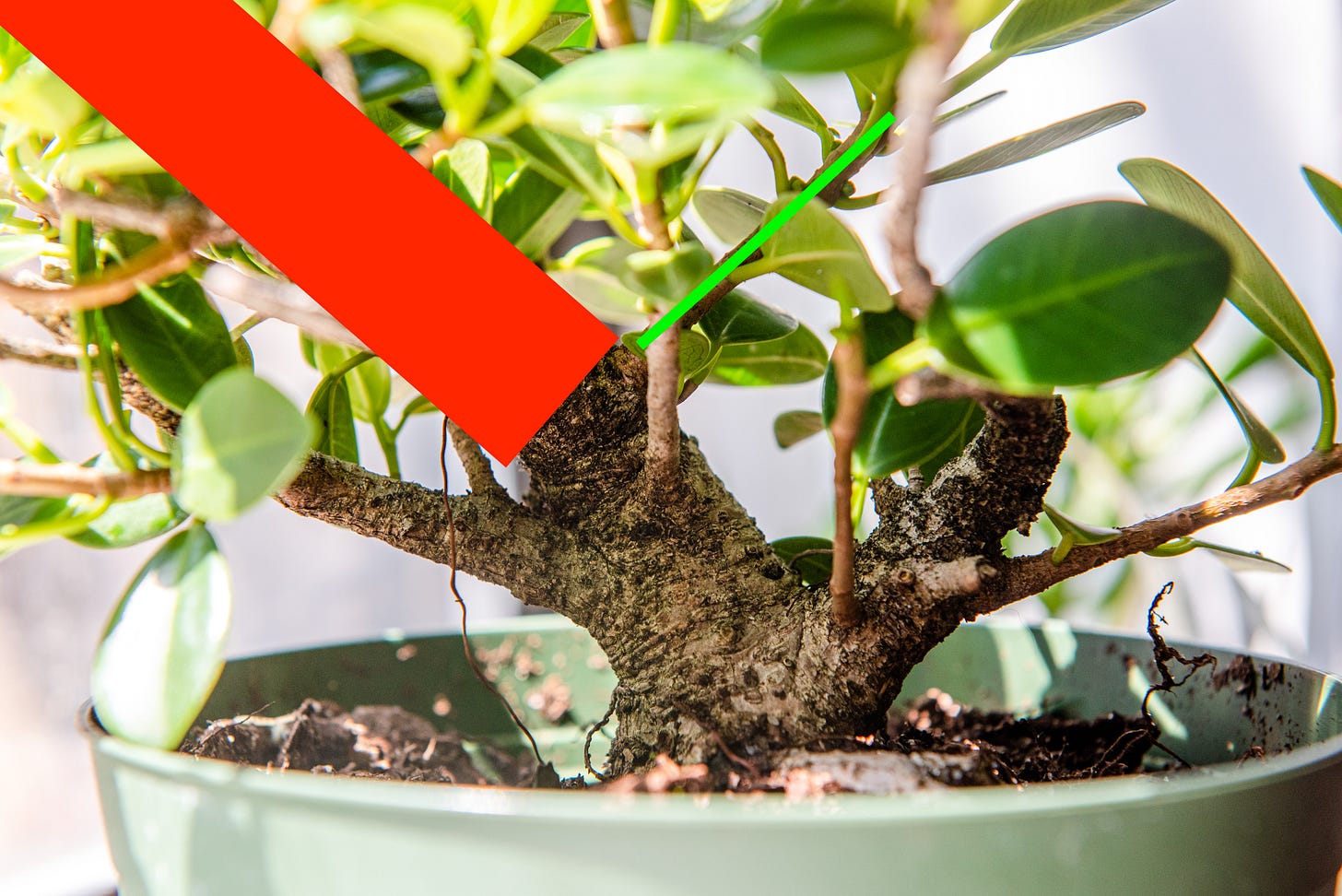The past few weeks I’ve been reading about growing plants indoors. Some of my trees, like my tea plant, have to come inside during the winter, and I have a corner of my kitchen in need of a job. So now, for 18 hours a day, the room emits a faintly ominous purple glow. These are basic LEDs with blue lights for foliage growth and red lights for flowers and roots. Cannabis growers love them.
Ficus are some of the most popular species for bonsai, especially if you don’t have outdoor space. Temperate trees like maples and pines can’t live inside for more than a couple months or years. Even with ideal light they need the temperature and humidity changes of the four seasons, including a dormant period during winter. Meanwhile, many tropical ficus can grow year-round, and a few species are easygoing enough to do so indoors.
All of which is a long way of saying, meet my ficus microcarpa, a $40 find from Wigert’s, a Florida bonsai nursery that specializes in tropical species.
Cute, right? Also kind of melting and droopy? Like those uncanny shar pei shaped ice creams.
All plants are plastic, capable of adapting to changes in their environment. But with ficus trees that tendency appears almost literal. Just look up old banyans in the wild; they practically ooze like candle wax.
Banyans like f. microcarpa and the national tree of India, f. benghalensis, are amazingly malleable. The Indian banyan actually begins as an epiphyte: a seed that germinates on another plant rather than in the soil. The banyan extends vines that wrap around a host tree and drops roots to anchor those vines to the ground. Eventually the banyan strangles its host to death. The host’s trunk decays, leaving behind a hollow melting squid of a ficus. As the banyan’s branches grow it drops more aerial roots into the soil, which over time become trunks of their own. It can form a whole grove this way.
Bonsai artists take advantage of plasticity with all kinds of trees, but the people who focus on ficus go to extreme lengths. A 40,000 member ficus group I lurk in on Facebook is called Ficus Study Group, which is pretty reflective of the forum’s culture. The work they do is amazing: root and branch grafts, propagations from huge cuttings, multi-trunked trees that look truly ancient. One technique I still can’t wrap my brain around is fusing: tying many young seedlings together or against a frame and letting them grow against one another until their trunks literally fuse into a single tree. This happens in the wild too, by the way. Trees, man.
I won’t start with anything that drastic for this microcarpa, but it needs a severe cut. Using sophisticated rendering software, I’ve made a graphic showing what I plan to do with the tree once it acclimates to its new home.
The leader outlined in red has grown out of proportion with the base of the tree and needs to be cut back. The branch highlighted in green will make a nice new zigzagging leader. I’ll lose about half the tree’s foliage in the process, but if I manage my microclimate right the tree should put out plenty of new branches.
Plasticity has been on my mind of late. I spend too much time on Twitter for my own good, and for the past few weeks that’s meant a ringside seat to vaccine hesitancy discourse. Most of the pro-vax camp’s discussion is about the anti side’s intellectual and moral positions. You would obviously come around if only you understood the data. Or, You’re a hypocrite and a coward who loves Trump more than your own grandmother.
Appeals to logic and morality make sense if you’re talking to a sentient moral being, but I think we’re a lot more like ficus: plastic and malleable, guided neither by pure reason nor dogmatic faith, but rather a million little circumstances that shape how we grow and put down roots. Essentially, you can’t debate an idiot, but at the same time I’m not convinced that most anti-vaccine people have enough personal agency to be justly condemned.
This isn’t because they’re weak minded or morally irresponsible. It’s because they, like all of us, are subject to manipulation. Harry Brewis has a great feature-length video about the British MMR scare of the early 2000s, in which one fraudulent doctor, a malignant lawyer, and a couple hundred members of the media essentially bullied a nation into believing a bogus link between the MMR vaccine and autism. The same cast is at fault here, and it boggles my mind that we don’t spend more time reminding each other of that.
I’m not sure what strategy the noble vaccinated should use to tend to their indigent Morlock kin, but I doubt treating them like ignorant goons or selfish cowards will do much good. Do keep applying pressure, though. Ficus can adapt.
Tree reading
Apparently the tumbleweed—maybe the emblem of the Great Plains to this dumb yankee—is an invasive species from Europe? And is causing havoc on farms and in grasslands?? And tumbleweeds detach from their root system by choice?!?! [Texas Monthly]
A neat guide to the official tree of each US state. I like that several states have the same tree. It’s nice that they share. [Reddit]






